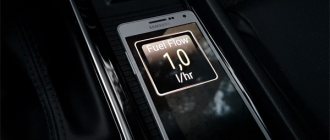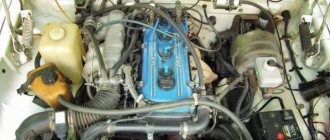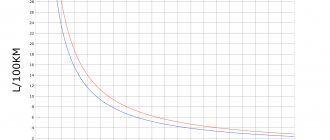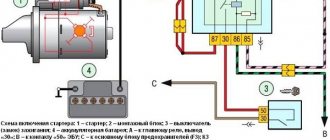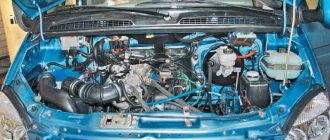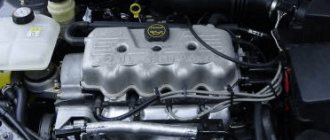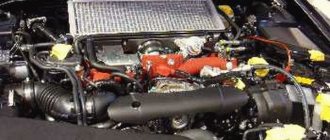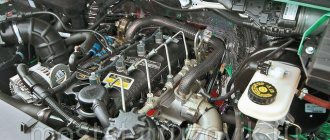Hi all. I want to know which oil is best to fill, it is advisable to know the viscosity and letters if according to SAE
Comments 38
I take SAE 15w-40 mineral all-season - SINTOIL, they advised me, I’m not complaining. I have a Volga 1995. And the price is not as expensive as semi-synthetics. Good luck!
Damn, I read it and was blown away. People have 402 ZMZ low-speed engines and they need mineral oil, 10 w40 mineral oil is just right. And pouring any semi-synthetics into it will only ruin the engine
Why so? Why is he worse than others?
5/40 I'm afraid to fill something, the sealing features... 10/40 semi-synthetic, I think, is just right.
I don’t even know what looks funnier, the question itself or the answers received xD I shouldn’t give such advice right away, here you have to choose from the condition of the engine and from the driving style, for example, if the engine is clearly not the first freshness, then something good and fluid is better not there pouring, well, if the current motor from the bulkhead is not worth pouring all sorts of dirty tricks) the most optimal approach is something semi-synthetic and within reasonable limits (for the price) to pour. z.y. After the overhaul, I myself drove a Lukoil mineral water, it was quite suitable, by the winter I switched to a semi-blue Lukoil, later a TNK, so-so, of course, but it’s quite possible to drive.
Well, the engine is 94 years old, the mileage of the engine is not high, because my grandfather drove it
still not an indicator. Some people on such engines in the same situations start pissing from all the cracks after meeting the half-blue. Many seals of those times were not designed for this. If you check everything and install high-quality seals everywhere, then you can even drive in blue, but I wouldn’t recommend filling it above the average half-blue.
Lukoil semi synthetic super 5w40
don't pour it in, it leaves a lot of carbon deposits, especially since 540 is not for our engines, I fill it with Esso 1040
I used Mobile 2000 10W40 in winter and summer, there was no snotty feeling, but in winter it was hard to start!
For everyday driving - semi-blue 10W40, cheap and cheerful. For active driving - blue 5W40 (higher thermal stability). For active driving on a gas-burned engine - diesel truck or gasoline racing blue 5W40 or 5W50 (many anti-wear additives, in the latter case even better thermal stability).
In the first two cases, the class is not younger than API SL.
Motul 4100 Turbolight 10w40
The letters according to the API (sae are just numbers) are not about this motor at all))) it’s better not to chase those that are particularly pathetic in the alphabet.
The 402 engine is not particularly sensitive to the composition of additives, but does not like high base number and poor fluidity, because has a specific lubrication system for the timing mechanism where oil starvation often occurs at low speeds. A high base number (for turbo and diesel engines) is harmful for almost all aluminum engines. For the rest, as already mentioned, you need to look for a good, genuine base; in different years, any viscosity was recommended for it, even at the manufacturer level: 15w30 and 10w30 and 15w40 and 10w40 and 20w50. The golden mean is 10w40. 5w... only if the motor is ideal. If not, then only in winter. It will drip. …w30 would not recommend above plus 20. 20w50 in extreme heat or “finish” the engine. But not lower than -5. It may pull up the earbuds.
Characteristics of the ZMZ-402 engine
90
| Production | ZMZ |
| Engine make | ZMZ-402 |
| Years of manufacture | 1981-2006 |
| Cylinder block material | aluminum |
| Supply system | carburetor |
| Type | in-line |
| Number of cylinders | 4 |
| Valves per cylinder | 2 |
| Piston stroke, mm | 92 |
| Cylinder diameter, mm | 92 |
| Compression ratio | 8.2 6.7* |
| Engine capacity, cc | 2445 |
| Engine power, hp/rpm | 100/4500 90/4500* |
| Torque, Nm/rpm | 182/2500 172/2500* |
| Fuel | 92 76* |
| Environmental standards | — |
| Engine weight, kg | 181 184** |
| Fuel consumption, l/100 km - city - highway - mixed. | 13.5 — — |
| Oil consumption, g/1000 km | up to 100 |
| Engine oil | 5W-30 5W-40 10W-30 10W-40 15W-40 |
| How much oil is in the engine | 6 |
| When replacing, pour, l | 5.8 |
| Oil change carried out, km | 10000 (better 5000) |
| Engine operating temperature, degrees. | |
| Engine life, thousand km - according to the plant - in practice | 200 200 |
| Tuning - potential - without loss of resource | 120-130 |
| The engine was installed | GAZ 2410 GAZ 3102 GAZ 31029 GAZ 3110 GAZ 31105 GAZ Gazelle GAZ Sobol |
* - for engines ZMZ 4021.10 and 4025.10 ** - engine weight for Gazelle
Operation depends on correct ignition
Automotive power units work productively if the ignition system is adjusted to 402 fuel-air mixture. The carburetor forms the fuel composition and supplies the prepared mixture to the engine cylinders.
At the moment of the highest position of the pistons, the spark plugs generate a spark that ignites the fuel mixture in the combustion chamber. A mini explosion of fuel with the resulting gases presses on the pistons, turning their forward motion into torque of the crankshaft.
The algorithm for igniting the mixture highlights one important point in the sequence of events. Will the engine work fully if the mixture is ignited at the beginning of the piston lifting or lowering? The correct answer is no.
Any internal combustion engine works like a clock, provided the fuel is properly ignited. The power of the power plant increases, approaching the established standards. To do this, it is necessary to fix the correct spatial position of the distributor, which alternately closes the electrical circuit from the high voltage coil to the car spark plugs.
Read more: Distance from Abkhazia to Krasnodar
Malfunctions and repairs of the Volga/Gazelle ZMZ-402 engine
The ZMZ-402 engine is one of the most famous and popular engines from the Volga region, it is an aluminum block, with wet cast iron liners, with a lower camshaft, a valve driven by rods and rocker arms, in fact, it is a slightly modified ZMZ 24D, in which they changed exhaust manifold, cylinder head studs, a camshaft with a lift of 9.5 was installed instead of 9 mm, the head itself was slightly adjusted, the oil pump was changed, and other, less significant things were also changed. The ZMZ-402 engine is the highest point of development of the GAZ 21 engine, the same engine designed in the 50s...
Modifications of the ZMZ 402 engine:
1. ZMZ 402.10 - the main and most common engine, SZh 8.2, uses 92 gasoline. Used on Volga 2. ZMZ 4021.10 - engine with reduced coolant to 6.7, for 76 gasoline. Used on Volga 3. ZMZ 4022.10 - engine with prechamber-torch ignition. This type of engine was distinguished by a different cylinder head, intake, exhaust, a different camshaft, a modified carburetor and, in general, a more complex design. All these innovations were supposed to improve technical characteristics, efficiency, toxicity, etc. The result was a structurally complex motor, the efficiency was not so noticeable and further work was required to improve it, so in 1992, the production of prechamber engines was curtailed. 4. ZMZ 4025.10 - an analogue of ZMZ 4021.10, but for cars of the Gazelle family. 5. ZMZ 4026.10 - an analogue of ZMZ 402.10, but for cars of the Gazelle family.
Review of faults and methods for repairing them
In principle, the ZMZ 402 motor was not fully developed from the very beginning, since at the time of its creation there were already more advanced technical solutions. The main advantage is safety when cutting the timing gear teeth - the piston does not bend the valve.
But the crankshaft is ground using a centerless method, radial runouts occur, and at speeds above 2500 - 2700 rpm, the rope rear oil seal cannot cope with the task. The exhaust goes into the crankcase and the oil pressure increases. The following malfunctions are typical for motors of the ZMZ 402 family:
| Oil leak | the gasket burns out due to stronger heating of the middle part of the cylinder head | gasket replacement and timely tightening |
| Motor overheating | breakdown of the pump, thermostat, air lock in the cooling system | replacing the pump/thermostat, removing the plug |
| Vibrations | imbalance of the ignition system, carburetor or flywheel, wear of pillows | balancing systems, replacing pillows |
Knocking can occur in crankshaft bearing shells and valves, but disappears after replacement.
Volga/Gazelle ZMZ-402 engine tuning
Forcing ZMZ 402.
How to boost the ZMZ 402 engine correctly and without loss of service life, for this we will need to increase the carburetor diffusers to 26/30mm, install a camshaft (for example OKB Engine 35) and a direct-flow exhaust of equal diameter along the entire length. This tuning can easily be done with your own hands; the output engine power will be 120-130 hp. To increase efficiency, you can mill the cylinder head to a height of 93mm, to increase the compression ratio, this will give a few more horses. There is no point in installing a worse camshaft and spinning it into the sky, the ZMZ-402 uses a heavy tractor piston group, all the plus will go to inertial losses and friction, with this step we will not get anything other than a speedy overhaul. You can try to solve the problem by installing a forged lightweight piston, a lightweight crankshaft, balance it, and still after 6000 rpm the engine will blow out, thanks to the special design of the cylinder head, this issue cannot be solved, and buying forging is completely irrational.
ZMZ-402 Turbo. Compressor for 402 motor
The easiest way to inflate a Volga is to buy a compressor, for example SC-14, and blow into the carburetor. There is no need to strengthen the ShPG, it holds pressure up to 0.5-0.7 bar, the exhaust needs to be replaced with a completely direct-flow one. This method is not distinguished by the elegance of its execution, and therefore, in order to get a serious effect, we need to convert the engine to an injector, change the ShPG and crankshaft to forged ones, install a camshaft, receiver, SC-14 or Eaton M90 compressor, configure everything online in January. This will go faster than the 406 engine, but the cost... As for the turbine, in addition to the above, we will need a turbo kit or assemble it ourselves, weld a manifold for the turbine, the turbine itself, pipes, 440cc injectors, select shafts, exhaust on a 63-76 pipe, we need Be sure to inject the engine and in the end the cost will result in 2-3 times the price of the car. That’s why no one installs a turbine on a 402 engine. The best choice for upgrading the ZMZ 402 is either a naturally aspirated version or a replacement for a ZMZ 406 engine or 1JZ-GTE.
1JZ to Volga
The 1JZ-GE / 1JZ-GTE engine is one of the most common swap options for the Volga, it becomes without any problems, moreover, GAZ 3102 were produced from the factory with such an engine, so this is the most optimal choice for upgrading your ZMZ-402, look for a donor, look service with experience in such work (fortunately there are a lot of them), arrange the conversion and enjoy the significantly increased power, efficiency, silence and reliability of the legendary 1JZ engine.
How the ignition system works
For the ZMZ 402 model, this order looks like this:
The car engine is started by turning the key in the ignition switch - at this moment the charge from the battery is supplied to the starter, which begins to rotate the crankshaft, activating the distributor (via the drive). At this very moment, electric current is supplied to the coil, then through the commutator the charge is supplied to the spark distributor (distributor), which in turn distributes the current through the wires to the cylinder spark plugs.
IMPORTANT to know that the switch is a block of transistor switches that serves to control the currents that pass through the inductor.
Read more: 6Pk1703 belt KAMAZ 6520 generator
Early ignition
One of the most common problems with the ignition system is too early an ignition timing angle - this is when, when fuel is supplied to the engine cylinder, the working mixture of gasoline and air in the combustion chamber ignites much earlier than the piston approaches top dead center. If the initial ignition timing is set too early, then problems with the vehicle's performance may occur. To avoid this, you should pay attention to signs of early ignition. And this is: • The engine does not start the first time (the crankshaft turns in the opposite direction when starting the engine) • Unstable operation of the engine at idle • Detonation of unburned fuel (a chirping sound appears that does not disappear when the speed increases) • Carbon deposits on the spark plugs ignition (fuel that is not completely burned is deposited on the spark plug) • Shots in the muffler (fuel burns due to misfire of the ignition) • Black smoke from the muffler (fuel that is not burned in the combustion chamber burns out) • Increased fuel consumption
Late ignition
On engines with a carburetor power supply system, late ignition is the ignition of the fuel mixture at the moment when the piston has already reached top dead center or has already passed it. When the engine operates this way, fuel consumption increases, power and throttle response deteriorate. The main signs of late ignition are: • Trouble starting the engine (several attempts are needed) • Sluggish vehicle dynamics while driving (the engine stalls when the speed increases) • Spark plugs are light gray or white • Shots in the carburetor (fuel burns out in the intake manifold) ) • Engine overheating (the mixture burns out during the expansion stroke, which contributes to engine overheating)
Technical characteristics of GAZ-31105 with Chrysler engine
GAZ-31105 Volga received a new improved Chrysler engine, which added power and dynamic data. Of course, some structural elements had to be slightly modified, but the manufacturer coped with this task perfectly.
"Volga-31105", the Chrysler engine on which was installed, received new technical characteristics. To use the car's full potential, a 2.4 Dohc Daimler Chrysler engine was installed, which had a power of 137 horsepower. Since the old gearbox was unable to function with this engine, the designers had to develop a new 5-speed manual gearbox, which was equipped with new bearings to more efficiently use the potential of the internal combustion engine.
Also, the GAZ-31105 Volga was able to reduce the acceleration time from 0 to 100 km, and this figure was only 11 seconds. This meant that the new engine was more powerful than its domestic counterpart. The maximum speed that the Volga-31105 developed (the Chrysler engine was the driving force) was 178 km/h.
The new Volga was more economical compared to its counterparts. So, the average fuel consumption was about 9 liters, while on the highway it was 7.8 liters, but in the city it was 10.8 liters. This is about 1-1.5 liters less than with the 405 or 406 engine.
Volga-31105 (Chrysler engine) was produced only briefly, from 2007 to 2009, but during this short period of time it managed to gain an army of fans.
Pros and cons of installing a Chrysler engine on a Volga
Of course, this car had many both positive and negative qualities. Having collected different opinions of people, which included experts, professional drivers, car mechanics and ordinary owners, we managed to highlight and systematize all this. Let's take a closer look at the pros and cons. So, what are the advantages and disadvantages of the Volga-31105 (Chrysler engine)?
Pros:
- Increased engine power.
- The engine life has increased by 1.5 times.
- Fuel consumption has decreased.
- Dynamic characteristics have increased.
- The noise has decreased.
- The car began to comply with the Euro-4 standard.
But along with the positive qualities, there are also disadvantages. Some of them were also used in domestic engines.
- Gasoline consumption is still high, which takes a toll on the owner’s pocket.
- The cost of servicing this type of engine increased compared to domestic versions, since spare parts were now pegged to foreign exchange rates. Of course, in this situation there is a way out - to buy analogues.
- There was a slight difficulty in repairing. The price for the work carried out on the engine was equal to the repair of a Chrysler.
Thus, it becomes clear to any consumer that car maintenance and repairs have become more expensive, but they have been replaced by reliability and confidence.
Chrysler engine maintenance
In a GAZ car, the Chrysler engine is quite easy to service. What is included in this operation? Changing the oil and oil filter, diagnosing spark plugs and checking high-voltage wires.
The recommended time between maintenance is 10,000 km + - 1,500 km. Mainly, this only includes replacing the lubricating fluid in the engines and the filter element. Let's take a closer look at the process:
- We put the car in a pit or drive it onto a lift. For safety reasons, so as not to burn anything, let the car cool down.
- Remove the protective screen that covers the motor from below.
- There is a drain plug on the engine crankcase, which should be unscrewed after clearing it of dirt and debris. Important! Don’t forget to prepare a 7-liter container, since Chrysler engines contain 6.5 liters of oil. Place it under the drain hole and wait for the oil to drain.
- Now you can tighten the drain channel. A new seal must be installed on the drain plug.
- Using a special puller, unscrew the oil filter. The new element must be screwed in by hand; there is no need to screw it in very tightly. First you need to pour a little oil into it.
- Pour 6 liters of oil through the filler neck. We twist it. Now you need to start the engine and let it run for a while. Next, add oil to the required level. This indicator can be viewed on the dipstick.
After completing all the operations and warming up the engine again, it is worth checking to see if there are any drips.
